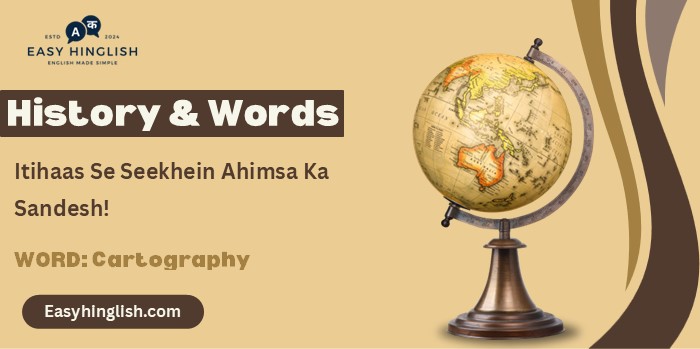History & Words: 'Cartography' (November 18)
Welcome to 'History & Words.' Main Prashant hoon, Wordpandit aur Learning Inc. Network ka sansthapak. Yeh series meri bhasha seekhne ki lagan aur itihas ke prati ruchi ka sangam hai. Har kadi ek shabd aur uss se judi ek tithi par roshni daalti hai, jisse aapka shabdkosh badhta hai aur aap itihas ko gehraai se samajh paate hain. Aaiye, iss safar mein shabdon ke madhyam se samay mein pichhe chalein.
🔍 Aaj ka Shabd: Cartography
Pronunciation: /kɑːrˈtɒɡrəfi/ (kar-TOG-ruh-fee)
🌍 Parichay (Introduction)
18 November 1883 ko ek aisa din tha jisne duniya ke time ka concept forever change kar diya. Iss din American aur Canadian railroads ne five standardized continental time zones introduce kiye, jo thousands of local times ki confusion ko khatam kar diya. Yeh decision sirf trains ke liye nahi tha – yeh cartography ke field mein ek revolutionary moment tha.
Cartography, yaani map-making ka science, uss din ek nayi challenge face kar raha tha. Ab maps mein sirf rivers, mountains aur cities nahi, balki invisible time boundaries bhi show karne the. Yeh woh din tha jab cartographers ko realize hua ki time bhi geography ka hissa hai.
Iss event ne prove kiya ki cartography sirf drawing nahi – yeh human civilization ko organize karne ka powerful tool hai. Modern world mein jahan GPS aur digital maps hain, woh sab ki foundation yahi traditional cartography mein hai.
🌱 Shabd ka Utpatti (Etymology)
"Cartography" French word "cartographie" se aaya hai, jo further Greek words se bana hai:
- "khartes" – map ya papyrus sheet
- "graphein" – to write ya draw
Yeh word 19th century mein officially use hua, lekin map-making ka practice thousands of years purana hai. Initially iska matlab sirf geographical features draw karna tha, lekin gradually iska scope expand hua. Aaj cartography mein time zones, weather patterns, population density – sab kuch include hota hai.
📖 Mahatvapurn Shabdavali (Key Vocabulary)
- 🔑 Meridian: Earth par north-south line jo longitude indicate karta hai
- 🔑 Projection: 3D Earth ko 2D map par represent karne ka method
- 🔑 Topography: Land ke physical features ka detailed description
- 🔑 Geospatial Analysis: Geographic data ko analyze karne ka process
- 🔑 Time Zone: Earth ke specific region mein uniform time system
🏛️ Itihasik Sandarbh (Historical Context)
Cartography ka journey ancient civilizations se shuru hua. Babylonians ne clay tablets par maps banaye, Greeks ne spherical Earth ka concept diya, aur Roman Empire ne road maps develop kiye administrative purposes ke liye.
Medieval period mein Islamic scholars ne cartography ko astronomy aur mathematics ke saath combine kiya. Al-Idrisi ka world map 12th century mein Europe ka reference bana. Chinese civilization mein bhi accurate mapping techniques develop hui, especially Zheng He ke maritime expeditions ke time.
Age of Exploration (15th-17th century) mein cartography ka golden period aaya. Mercator projection (1569) ne navigation ko revolutionize kiya. Captain Cook ke expeditions ne Pacific ko accurately map kiya. Yeh era mein cartography aur colonialism ka deep connection bana – maps power ka symbol the.
Industrial Revolution ke saath cartography bhi modernize hui. Railway expansion ke liye detailed maps zaroori the, jo eventually time zones ki zaroorat create kari.

⏳ Samayrekha (Timeline)
- 600 BCE: Anaximander ka world map (Greece)
- 150 CE: Ptolemy ka "Geography"
- 1154: Al-Idrisi ka detailed world map
- 1569: Mercator projection introduce hui
- 1784: Britain's Ordnance Survey established
- 1883: November 18: Time zones standardized
- 1957: First satellite mapping (Sputnik era)
- 1973: GPS technology development start
- 1995: Google Maps launch
🌟 Is Din ka Mahatva (The Day's Significance)
18 November 1883 se pehle America mein 300+ local times the. Har city apna sun-based time follow karta tha, jo railroad operations ke liye nightmare tha. Trains constantly scheduling conflicts face kar rahi thi, aur accidents bhi ho rahe the confusion ki wajah se.
Railroad companies ne realize kiya ki standardized time system zaroori hai. William F. Allen, jo General Time Convention ka secretary tha, ne four time zones ka proposal diya. November 18, 1883 ko yeh system implement hua, jisse "The Day of Two Noons" kaha gaya kyunki kuch places mein noon twice observe hua.
Iss decision ka cartographers par huge impact hua. Ab unhe invisible boundaries draw karne the jo purely time-based the. Time zone maps ek completely new category ban gayi. Yeh first time tha jab human-made concept (time) ko geographical maps mein represent kiya gaya.
Congress ne officially time zones recognize kiya 1918 mein, lekin practical implementation 1883 se hi start ho gayi thi. Yeh decision ne international timekeeping ka foundation rakha – eventually 24 global time zones ban gaye.
💬 Prasiddh Ukti (Quote)
"The mapmaker's art is more ancient than the art of writing."
— Carl Sauer, Geographer
🔮 Aaj Ka Matlab aur Chintan (Modern Usage and Reflection)
Aaj ke digital age mein cartography ka meaning completely transform ho gaya hai. Google Maps, GPS navigation, satellite imagery – yeh sab modern cartography ke forms hain. Real-time mapping, traffic data, weather overlay – traditional maps se kaheen zyada interactive aur dynamic hai.
Geographic Information Systems (GIS) ne cartography ko data science ke saath merge kar diya. Aaj urban planning, disaster management, climate studies – sab mein advanced mapping techniques use hoti hain. COVID-19 pandemic mein bhi infection tracking maps ne crucial role play kiya.
🏛️ Virast (Legacy)
Time zones ki standardization ne modern globalization possible banaya. International business, aviation, internet communication – sab kuch standardized time par depend karta hai. Cartography ne yeh invisible infrastructure create kiya jo modern world ko bind karta hai.
Digital cartography ne democratized mapping – ab har individual custom maps create kar sakta hai. Open-source mapping projects jaise OpenStreetMap ne traditional cartography ko collaborative effort bana diya.
🔍 Tulnatmak Vishleshan (Comparative Analysis)
1883 mein cartography purely physical representation tha – paper par lines aur colors. Aaj cartography interactive, real-time, multi-dimensional hai. Pehle maps static reference tools the, ab yeh dynamic decision-making platforms ban gaye hain.
Traditional cartographers manually survey karte the, aaj satellites aur AI automatically mapping kar rahe hain. Accuracy level meters se centimeters tak improve hui hai.
💡 Kya Aapko Pata Hai? (Did You Know?)
🎓 Antim Vichar (Conclusion)
Cartography sirf maps banane ka science nahi – yeh human civilization ko organize karne ka tool hai. November 18, 1883 ka time zone standardization prove karta hai ki invisible concepts bhi geographical significance rakh sakte hain. Aaj bhi har digital map mein woh same principles work kar rahe hain jo centuries pehle traditional cartographers use karte the.
📚 Aage Padhne Ke Liye (Further Reading)
- 📘 The Power of Maps – Denis Wood
- 📗 Longitude: The True Story of a Lone Genius – Dava Sobel
- 📙 The Map That Changed the World – Simon Winchester








